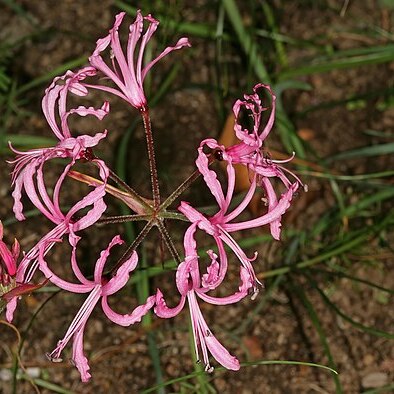A small nerine with a scape of about 30 cm in length, 8 to10 pedicels 2-5 to 3-8 cm long, perianth segments 2.5 to 3 cm long and 3 to 4 mm in width. The filiform leaves are very slender, about 1 mm in diameter. The pubescence on the scape and pedicels is very conspicuous. The filaments are about the same length as the segments, or slightly shorter. The segments, whilst twisted and undulate for about a third of their length are not strongly recurved as in N. filamentosa. No staminal appendages. The segments tend to curve sideways and upwards.
Geophyte, up to 300 mm high, plants caespitose. Leaves many; present at flowering; blade filiform, 150-200 mm long. Flowers: in a 8-12-flowered umbel; pedicels 25-38 mm long, pedicels glandular with stalked glands; stamen appendages absent; perianth angled downwards, zygomorphic, with tube 2 mm long, lobes linear, narrowly ovate, 25-30 x 3-4 mm, rose pink; Dec.-Apr. Fruit a subglobose, membranous capsule.
Perennial geophyte, up to ± 0.3 m high. Leaves often dry at flowering, terete, ± 1.5 mm wide. Flowers in ± open heads; perianth 20-25 mm long, pink, segments linear, ± 2 mm wide, distinctively rolled back from tips; stamens prominently exserted, ± twice as long as segments. Flowering time Mar., Apr.
Perennial geophyte, up to ± 0.3 mm high. Leaves evergreen, filiform, ± 1 mm wide. Flowers in a neat cluster; perianth 25-40 mm long, pink, segments narrowly lanceolate, ± 3 mm wide, twisted and undulate in upper 1/3, ± as long as stamens. Flowering time Mar.-May.

